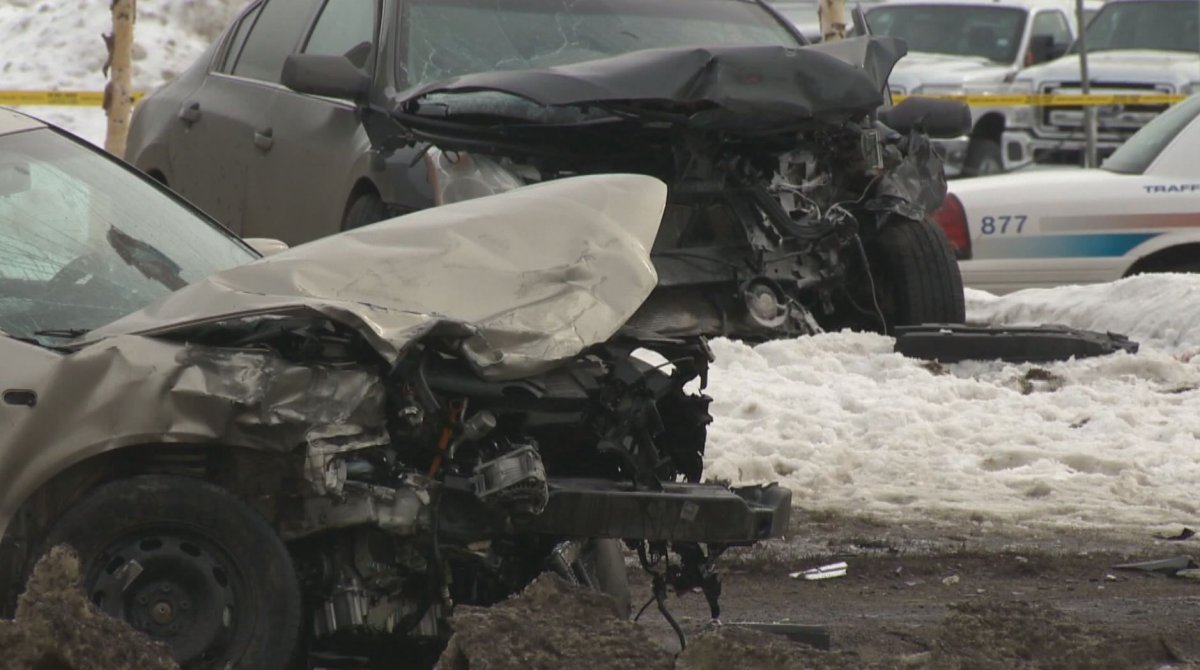An Alberta judge has recommended stricter probationary periods for police recruits across Alberta, after an elderly woman was killed in a collision with an undercover Edmonton police car.

On March 8, 2012, during a non-emergency call in south Edmonton, Const. Chris Luimes was driving nearly 120 kilometres an hour — double the 60 km/h speed limit.

The officer was working with a team of investigators that morning, doing surveillance work in a criminal case to learn more about a suspect’s habits and lifestyle. “There was no urgency to this surveillance,” the fatality inquiry report said.
While following the suspect, Luimes was driving north on 75 Street and was racing to catch up. Luimes was in plain clothes and driving an unmarked Nissan Altima police car with its lights and siren off.
At the same time, 84-year-old Anne Walden was driving her Volkswagen Jetta south on 75 Street and tried to make a left-hand turn onto 76 Avenue. She turned into the path of the officer’s vehicle, and they collided.

Get breaking National news
Annie Cecelia Walden died in the ambulance on the way to the University of Alberta Hospital from chest injuries due to blunt force trauma.
- Marcellus Williams: Missouri executes ‘innocent’ man despite push to free him, advocates say
- Sean ‘Diddy’ Combs accused of filming rape in latest lawsuit
- Alex Jones’ Infowars assets to be auctioned off for Sandy Hook payments
- Trump shooting suspect’s son arrested on child sex abuse image charges: FBI
Luimes was not wearing his seatbelt and suffered a serious broken leg. He was charged with dangerous driving causing death, but in May 2015 found not guilty due to lack of evidence.
READ MORE: Edmonton police officer not guilty of dangerous driving causing death
The fatality inquiry carried out by provincial court judge Carrie Sharpe last March looked into several areas. Was it necessary for the unmarked police vehicle be driven so fast? What were Edmonton police policies for mobile surveillance at the time? Have those policies changed since? What training had officers received prior to the crash? Has training changed since the collision?
Justice Sharpe’s fatality inquiry report made only one recommendation: all police agencies in Alberta should have a probationary period of three months, six months, and one year to continuously evaluate the driving habits of new police recruits. Sharpe said if a supervisor identifies performance or safety concerns during that time, the member can be removed from his or her current position.
Edmonton police said they have had that very policy in place since 2012, as a result of their own internal review of the collision.
Sharpe said all other training and safety recommendations she would have made have since been implemented by the Edmonton Police Service, as a result of the 2012 collision.
READ MORE: Driving culture changed among Edmonton police members following fatal crash: senior officer
Edmonton police said their most significant change was increased training for surveillance team members: instead of the mandatory “basic” one-week course previously provided, all members must now go through a three-week advanced surveillance course.
“Members are not allowed to conduct mobile surveillance without the new advanced training,” a statement from EPS said Tuesday. “This course is taken by all EPS members who are to do surveillance in any capacity. The EPS stresses driving safety and accountability in the course.”
During surveillance, the supervisor is in constant communication with the members of the on-street team and can order officers to stand down if there are safety concerns.
There is a system in place for supervisors to track the driving infractions of individual officers. Police officers are now held accountable for speeding on duty and there are consequences for repeat offenders, the report said.
Although there are provisions in provincial legislation that allow officers to break the rules of the road, Edmonton police policy states they must stop at intersections and proceed only when it is safe to do so, and they must be justified when exceeding the speed limit.
Police said a limit on the driving speed of an undercover officer was put in place approximately a year ago, but the change was made for safety purposes, not as a result of the inquiry.
Only two witnesses testified at the March 14, 2017, fatality inquiry: EPS Supt. Brad Doucette and the investigating officer for the Alberta Serious Incident Response Team, which investigates all serious incidents involving police officers.
Const. Luimes still works for EPS in the patrol division. Last year, he appeared in a video about the collision and its ramifications. EPS said viewing the video is part of required training for all EPS sworn members.






Comments